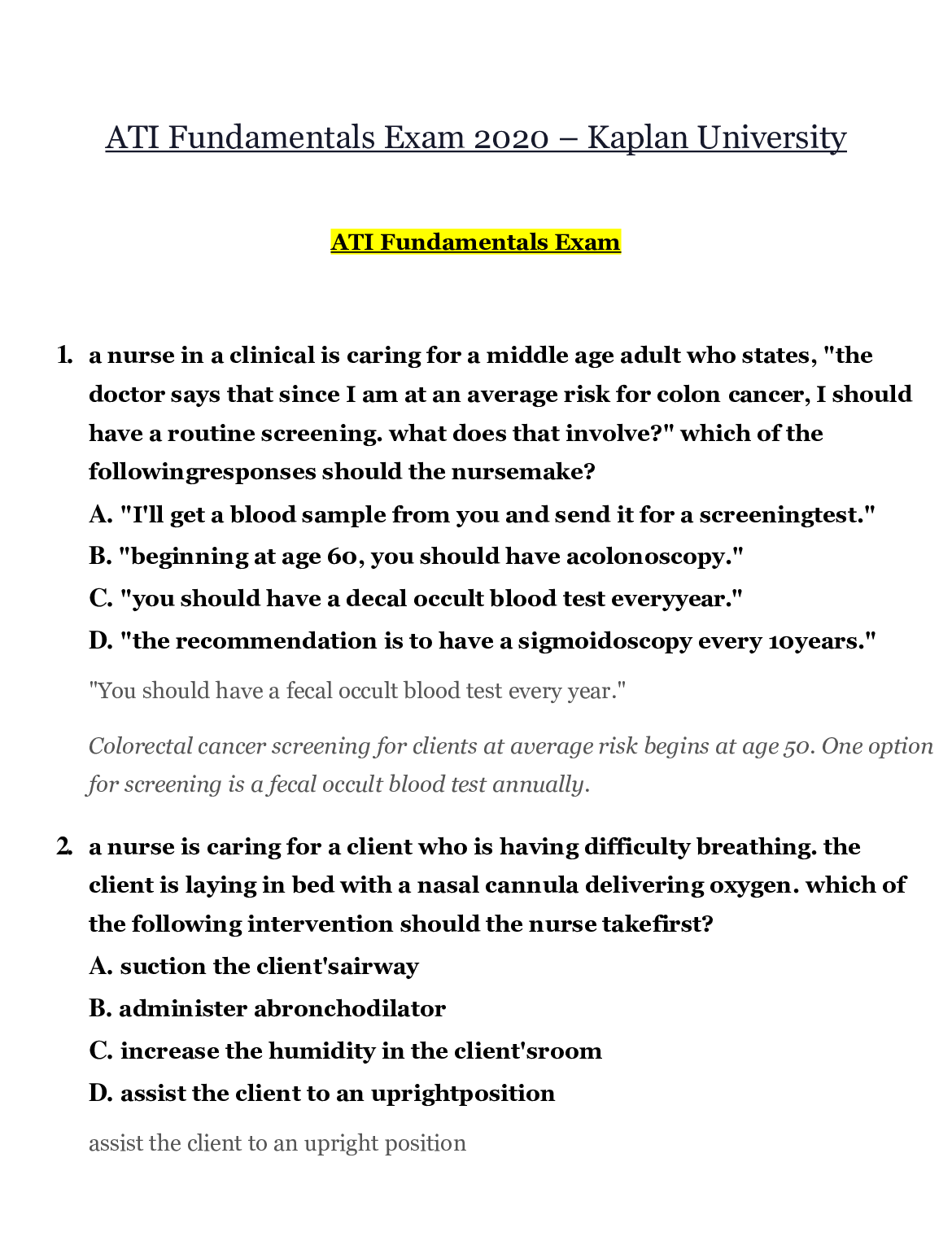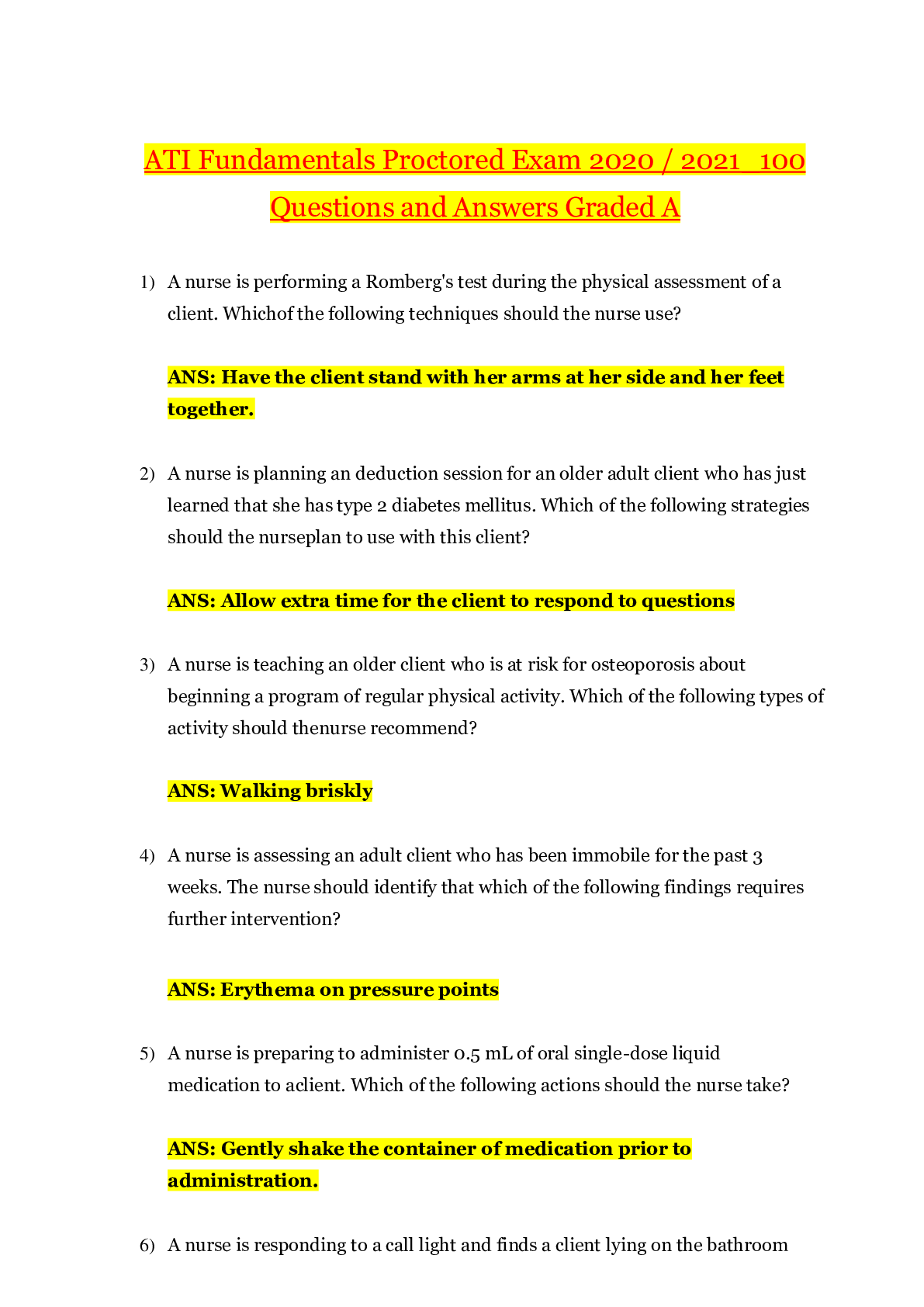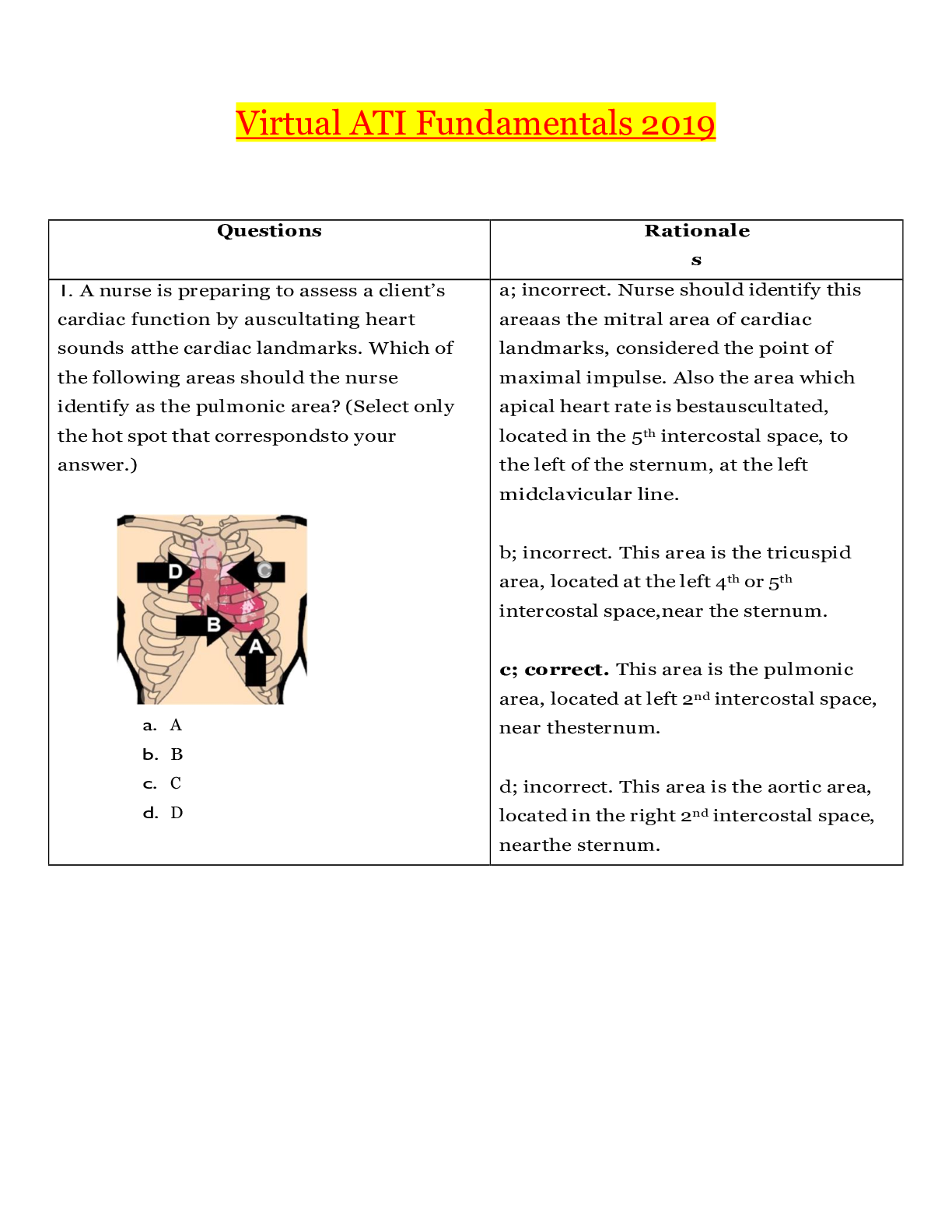*NURSING > EXAM PROCTORED > ATI RN GERONTOLOGY FINAL QUIZ 2022/2023 | NURS 212 ATI RN 2.0 GERONTOLOGY FINAL QUIZ_98% SCORE (All)
ATI RN GERONTOLOGY FINAL QUIZ 2022/2023 | NURS 212 ATI RN 2.0 GERONTOLOGY FINAL QUIZ_98% SCORE
Document Content and Description Below
NURS 212 ATI RN 2.0 GERONTOLOGY FINAL QUIZ 2022 A nurse is completing medication reconciliation for an older adult client who is receiving multiple medications. Which of the following actions sh... ould the nurse take first? A- Clarify the client list of medications with the pharmacist B- compare the current list against the new medication prescriptions C- investigate any discrepancies on that list D- ask the client about over the counter medications she is taking Answer- D The nurse should apply the nursing process priority-setting framework. The nurse can use the nursing process to plan client care and prioritize nursing actions. Each step of the nursing process builds on the previous step, beginning with assessment or data collection. Before the nurse can formulate a plan of action, implement a nursing intervention, or notify the provider of a change in the client’s status, she must first collect adequate data from the client. Assessing or collecting additional data will provide the nurse with knowledge to make an appropriate decision. When performing medication reconciliation, it is important that the nurse collect a list of all the medications the client takes in order to compare the full list of medications against any new medications the client will take. The list should include prescriptions, over-the-counter medications, and herbal and nutritional supplements. A- The nurse should clarify the client’s list of medications with the pharmacist, caregivers, providers, and the client; however, this is not the first action the nurse should take. B- The nurse should compare the medication list against any new prescriptions to ensure there is not any duplication of medications or potential medication interactions; however, this is not the first action the nurse should take. C- The nurse should investigate discrepancies on the list with the provider to prevent medication errors; however, this is not the first action the nurse should take. Exam 1? A nurse at a long-term care facility is planning care for a client who has Alzheimer's disease and wanders at night. Which of the following interventions should the nurse include in the plan? A- Place the client in wrist restraints at night B- request a prescription for a psychotropic medication C- assign the client to a room closer to the nurses station D- cheap the television on at night Answer- C The nurse should place the client who wanders in a room that allows for close observation. The nurse should provide clients who wander a safe place to walk and supervision when the client is ambulating. A- The nurse should protect the client from harm, but restraints can result in agitation. B- The nurse can administer a psychotropic medication to treat depression or emotional manifestations of Alzheimer’s disease, but not to treat wandering behaviors. D- The nurse should avoid the use of excessive light and sound stimulation for the client who has Alzheimer’s disease. This can cause further agitation and confusion for the client. The nurse at a long-term care facility is teaching an older adult client about ambulating with a quad cane. Which of the following statements should the nurse include in the teaching? A- Adjust the height of the cane so that you can flex your elbow at 45 degrees B- hold the cane in the hand on the stronger side of your body C- place the flat side of the cane away from your foot D- the cane and your stronger leg at the same time Answer- b The client should hold the cane with the hand on the stronger side of her body so that she can move the cane to support the weaker leg. This action allows for a more normal gait, with the ipsilateral arm and weaker leg moving at the same time. A- The nurse should instruct the client that the cane’s height should allow the elbow to be slightly flexed. Having a flexion of 45º would make the cane too tall for safe use. C- The client should place the flat edge of the base of the cane facing toward her foot. This allows the client to ambulate without the risk of getting her foot caught in the base of the cane and falling. D- The nurse should instruct the client to move the cane and her weaker leg at the same time. This action allows for a more normal gait with the ipsilateral arm and weaker leg moving at the same time. A nurse is performing a skin assessment for a group of older adult clients. Which of the following findings should the nurse identify as a benign, age related skin change commonly seen in older adult clients? A- Liver spots B- Nevi C- atopic dermatitis D- psoriasis Answer- a Liver spots, also known as age spots or lentigines, are flat, brownish-black macules that usually occur in sun-exposed areas of the body. Aging and exposure to sunlight, or other forms of ultraviolet light, can result in increased pigmentation. Liver spots are extremely common after 40 years of age; they occur most often on the forearms, shoulders, face, forehead, and backs of the hands, which are also the areas of highest sun exposure. They are harmless and painless, but they can affect the client’s cosmetic appearance. B- Nevi are moles, a growth of pigment-forming cells that might be benign or malignant. The nurse should identify that nevi occur throughout the lifespan. Further evaluation of the nevi should include evaluation of any asymmetry, border irregularity, color variation, diameter, and evolution, which can indicate melanoma. C- Atopic dermatitis, or eczema, is a chronic skin disorder that occurs in all ages, but is more common in infancy and childhood. Clients who have atopic dermatitis can have scaly and itching rashes. D- Psoriasis is a common skin inflammation with frequent episodes of redness, itching, and thick, dry, silvery scales on the skin. The nurse should identify that while generally a benign condition, psoriasis is a chronic, recurring condition in clients of all ages, most commonly in clients from 15 to 35 years of age. A nurse in an assisted living facility is assessing an older adult client who moved in three months ago following a death of his partner. The client reports Awakening early in the morning and admit to feeling very sad. The nurse should identify that the client is experiencing which of the following types of Grief? A- Anticipatory grief B- delayed grief C- acute grief D- disenfranchised grief Answer- c The client experiencing acute grief will have both somatic and psychological manifestations of distress, such as the inability to sleep well or profound sadness. The nurse should identify that this client is experiencing acute grief and further assess his support system, concurrent stressors in his life, and his ability to manage stress. A- The nurse should identify anticipatory grief as an expected response occurring prior to an actual loss. Clients experiencing anticipatory grief might be preoccupied with the impending loss, make extensive funeral arrangements, or exhibit a change in attitude toward the lost thing or individual. B- The client experiencing delayed grief is unable to accept the reality of a loss. The client remains in the denial stage of grief and is unable to allow himself to experience feelings of sorrow and loss. C- The client experiencing acute grief will have both somatic and psychological manifestations of distress, such as the inability to sleep well or profound sadness. The nurse should identify that this client is experiencing acute grief and further assess his support system, concurrent stressors in his life, and his ability to manage stress. D- The client experiencing disenfranchised grief cannot openly acknowledge the loss because of societal or religious norms. A nurse is providing teaching to a client who is to start taking alendronate sodium. Which of the following recommendations should the nurse include in the teaching? A- The medication may be crushed if you have difficulty swallowing it B- drink a full glass of milk when you take the medication C- take the medication at bedtime D- discontinue the medication if you develop heartburn Answer- d The nurse should instruct the client to stop taking the medication if she develops heartburn or if it worsens and to contact her provider. This is an indication that esophageal irritation has occurred. Ways to avoid this are to take alendronate with 240 mL (8 oz) of water and to avoid lying down for 30 to 60 min after taking the medication. A- The nurse should instruct the client that this medication must be taken whole. Crushing or chewing alendronate can cause esophagitis or esophageal cancer. B- The nurse should instruct the client to take alendronate with a full glass of water. Food or fluids other than water interfere with the medication's absorption. C- The nurse should instruct the client to take alendronate in the morning before eating or drinking. It is also important to reinforce that the client must remain upright for 30 to 60 min after taking this medication to avoid esophagitis. A nurse is caring for an older adult client who reports that he has just retired and expresses feelings of loneliness due to the loss of daily interactions with coworkers. Which of the following responses should the nurse make? A- Do you know about the local senior citizens group? B- You need to take a vacation. C- But now you can finally relax and enjoy your life. D- Why don't you go into work and visit with your old friends? Answer- a The nurse should assist the client in the resocialization process by using the therapeutic communication technique of giving information. Becoming involved in an organization might assist the client in resocialization, which is beneficial to clients who have depended upon their employment for social interaction. B- The nurse should avoid responses that give the client advice and do not address the client’s feelings of loneliness. C- The nurse should avoid challenging statements to the client who is experiencing social isolation. This response might belittle the client's feelings and minimize the importance of his message. D- The nurse should avoid asking probing-type questions because this is nontherapeutic and does not provide for resocialization and long-term adjustment. A nurse at a long-term care facility is planning care for an older adult client who has dementia. Which of the following interventions should the nurse include in the plan? A- Very the staff members caring for the client B- use photographs as memory triggers C- provide a minimum of 3 activity choices to the client D- break client asks down to 3-4 steps at a time Answer- b The nurse should place photographs on the unit that trigger the client’s memories, such as a picture of a toilet at the entrance to the bathroom, or a picture of the client as a young adult at the entrance to her room. A- The nurse should use consistent staff to provide care for the client because changing staff increases client confusion. C- The nurse should avoid offering many choices to the client as this increases confusion and frustration. While a variety of activities is important to stimulate the client, the nurse should limit choices to one or two. D- The nurse should offer simple, basic steps of a task to a client and limit the steps to one or two at a time. The nurse should ensure that the client completes one step before starting another. Providing the client with a number of steps to complete causes confusion and frustration. A nurse is providing teaching to a client who is to start taking finasteride. Which of the following statements by the client indicates an understanding of the teaching? A- I will see Improvement in my symptoms within one week B- I can expect and increased libido with this medication C- I should see a decrease in my PSA levels D- I must take this medication within 60 Minutes of sexual activity Answer- c The nurse should emphasize that the decrease in PSA levels with this medication will be measured 6 months after starting treatment. The expected decline is 30% to 50% in the PSA level. A- The nurse should reinforce that this medication might take up to 6 months before the client responds. B- The nurse should inform the client that one of the adverse effects of this medication is a decrease in libido. Other side effects include orthostatic hypotension, gynecomastia, and decreased ejaculate volume. D- The nurse should emphasize that this medication decreases mechanical obstruction of the prostate, and it has no effect on sexual activity. - - --- - -- - - - - -- Continued [Show More]
Last updated: 2 years ago
Preview 1 out of 31 pages

Buy this document to get the full access instantly
Instant Download Access after purchase
Buy NowInstant download
We Accept:

Reviews( 0 )
$13.50
Can't find what you want? Try our AI powered Search
Document information
Connected school, study & course
About the document
Uploaded On
Mar 02, 2021
Number of pages
31
Written in
Additional information
This document has been written for:
Uploaded
Mar 02, 2021
Downloads
1
Views
180














